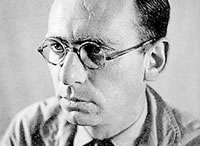Blue Plaque Installed On Patrick Hamilton's Childhood Home |
|||||
Unsung hero of twentieth-century fiction is honoured with installation on Burlington Gardens house
The novelist and playwright Patrick Hamilton (1904-1962), has been commemorated with an English Heritage blue plaque in celebration of his life and contribution to literature. The plaque was installed at 2 Burlington Gardens, Chiswick, W4 on Saturday (12th February). Hamilton has been described by his biographer Nigel Jones as “undoubtedly a major – arguably the major – novelist of mid-20th century London life”, and few people commemorated with a blue plaque can ever have had such a love-hate relationship with the capital city. Late in life, writing in an unfinished novel entitled The Happy Hunting Ground’he observed that ‘London’s a place where you’re forever hunting for happiness – and even if you find it it’s soon taken away from you’. Although never part of a particular literary clique Hamilton’s work was championed by the likes of Graham Greene, John Betjeman and J. B. Priestley. In recent years interest in Hamilton has increased: his play Rope was revived last year and a TV adaption of Twenty Thousand Streets Under The Sky, his novel trilogy, was aired in 2005.
Hamilton wrote his first novel Monday Morning (1925) when he was just nineteen but it was his second novel Craven House (1926) that set the tone for his writing with its candid observation of “shabby genteel” English life, effortlessly invoking the speech and manners of the inter-war era. It was the play Rope (1929) that made Hamilton famous; Alfred Hitchcock adapted it for film; Hamilton wrote the screen play, but regarded the end product as “sordid and practically meaningless balls”. Hamilton’s success as a novelist continued with The Midnight Bell (1929), The Siege of Pleasure (1932) and The Plains of Cement (1934). This trilogy – describing the colliding lives of a barman, a barmaid and a harlot in London’s West End, and partly inspired by Hamilton’s obsessive affair with a prostitute – was later issued as Twenty Thousand Streets under the Sky (1935). By this time Hamilton was married – to Lois Martin – and had suffered a nearfatal road accident in Earl’s Court in 1932 that stopped him from writing for nearly two years, and left him physically and psychologically scarred. He was to score his biggest commercial hit with the neo-gothic stage play Gaslight (1938); many regard his finest achievement as Slaves of Solitude (1947), a novel set in Henley-on-Thames. This was Hamilton’s home for a time, as were Hove and Reading, where much of the action in The Gorse Trilogy (1955) is set. By the time of the Second World War Hamilton’s marriage was failing and he embarked on Patrick Hamilton’s residence at the large Victorian corner-house on Burlington Gardens was intermittent, but his connection with the place lasted sixteen years and it was at this address English Heritage blue plaques historian, Howard Spencer, said: “Hamilton’s plays and novels Nick Robinson, Vintage Publishing Sales Manager, Random House, said “I am absolutely February 17, 2011 |

 Born in Hassocks, West Sussex, Patrick Hamilton was the youngest of the three children of
Bernard and Ellen Hamilton. He came from a literary family with both his parents – and later
both his siblings Lalla and Bruce – being published authors. At the outbreak of the First
World War the family moved to Burlington Gardens in Chiswick where the blue plaque is now placed.
Born in Hassocks, West Sussex, Patrick Hamilton was the youngest of the three children of
Bernard and Ellen Hamilton. He came from a literary family with both his parents – and later
both his siblings Lalla and Bruce – being published authors. At the outbreak of the First
World War the family moved to Burlington Gardens in Chiswick where the blue plaque is now placed.